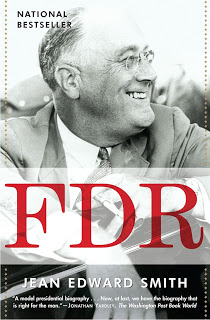
FDR
Jean Edward Smith
reviewed January 2019
Amazon lists this book at 880 pages. You would think 880 pages would be plenty when telling a biography about anybody. However, when one considers that William Manchester’s wonderful account of Winston Churchill took a total of 3 volumes totaling over 3000 pages, one can start to see that 880 pages covering such a massive historical figure as FDR might be cutting it a tad thin. After reading this book, those were my exact sentiments. A very well written book, but there simply should have been more. I still give this book 5 stars though, because I think it’s fair to review a book on what it is as opposed to what it is not.
Although there are lot of people that don’t or didn’t like Franklin Roosevelt, this book clearly shows us that the man was a brilliant orator and a master politician. The best leaders are ones that inspire; they lift us up when times are bad and show us that despite the travails of the country and the individual, we can and will persevere as a nation. FDR was the commander in chief during the two most calamitous times in history during the 20th century; the Great Depression and World War II. I find it somewhat interesting that the former didn’t end until the latter happened, but people stood by their leader with the depression a decade old because he made them feel good about themselves. This is the complete opposite of Roosevelt’s predecessor, Herbert Hoover. Many historians have correctly stated that Roosevelt’s plans and policies weren’t any more effective than Hoover’s, but the two presidents were night and day when it came to talking to an audience.
Roosevelt was born into prestige and gobs of old New York money. This, plus the fact that he was handsome and charming was the main reason why he was elevated to the top of local politics. The book seems to suggest that it’s only when Roosevelt succumbs to becoming a paraplegic due to the crippling disease polio, does his heart change for the common man. It’s also quite interesting to read about his hot and cold relationship with the somewhat crooked Tammany Hall political machine in New York City during the 1910s and 1920s.
Since I’ve read other books about FDR, as well as many books about FDR’s political counterparts, it’s impossible for me to read this book without making comparisons to other narratives I’ve read. For example, I thought this book was the best biography when covering his early years up to the first half of his presidency. To contrast, the book on FDR by James MacGregor Burns “The Lion and the Fox” (which covered FDR until 1940) was one of the most lifeless, drab books that I have ever read. I wish I had read this one and never bothered with the Burns volume. Ironically, the volume 2 of FDR by Burns, which covered the years 1940-1945, is actually much better than this particular bio. I think that was my main gripe about this book; the war years just weren’t covered in as much detail as they should have been. If I recall, Jean Edward Smith only devotes the last three chapters of this biography to the war years. As I’ve stated, 880 pages really isn’t enough to get the complete picture.
Speaking of book comparisons, my favorite compendium of FDR is Doris Kearns Goodwin’s “No Ordinary Time”. That book was more of a co-biography on FDR and wife Eleanor. That book focused on the war years as well, and really did an excellent job paying homage to Eleanor and the great things that she did for her country; mostly in different circles. FDR and Eleanor had a very strange marital relationship, and most of their latter years they seemed more akin as business partners than a married couple happy in love. Again, Jean Edward Smith only scratches the surface when discussing Eleanor as compared to the Doris Kearns Goodwin book.
I will say that the only thing about this book that left me feeling a bit cheated was the end. Yes, FDR died in office shortly after his fourth term began in April 1945, but it feels as though the author puts on the breaks to the story too fast. It’s possible that I felt this way since there was a lot of drama that occurred within the six months after FDR’s death; mostly the conclusion of World War II and how the U.S. got where they did. It feels as though there really should have been a coda that talked a bit about things such as Harry Truman, VE Day, and Hiroshima and Nagasaki. Yes, Roosevelt had left us by that point, but he did set the wheels in motion for all of those events to occur, and it would have made a better ending than the abrupt conclusion Smith gives us in this book.
I really enjoyed this book. FDR was such a well-known president, though, that I can’t help but recommend to the serious reader that they use this book as a starting point and continue their education with the many other volumes out there to get a more full picture of the times and the places where FDR was at center stage during such a tumultuous time in the nation’s history.
Go to the Next Review
Back To Main Page
E-mail your thoughts and opinions to Clem: clem@clemsmusicreviews.com